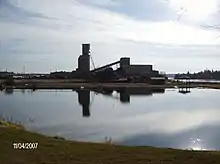Bissett, Manitoba
Bissett is a community in the Canadian province of Manitoba. Located two and a half hours northeast of Winnipeg on Manitoba Provincial Road 304, Bissett is an entry point to Nopiming Provincial Park. It is home to the True North Gold Mine (also called the Rice Lake Gold Mine), Wynne Drilling Corporation, Northern Wings Bed and Breakfast and the San Antonio Hotel. The township also hosts the base of operations for the Boy Scouts of America Northern Tier High Adventure Base, which operates canoeing expeditions in the nearby Atikaki Provincial Wilderness. There is a school which features a half day nursery/kindergarten and one of the last remaining Grade 1 - 9 classrooms in Canada.


History
Situated on Rice Lake, the town was named after physician, surgeon and politician Edgar Douglas Richmond Bissett, a Member of Parliament from September 1926 until July 1930. Gold was discovered in the rural community in 1911 and was a steady industry for many years until closure of the mine in 1983. Mining executive John Draper Perrin helped finance the development of the town.
The community was recognized in 1972, and is represented by a mayor and council. The 1996 population was 159, and in 2012 it is approximately 125, although it rises significantly during the summer when the lake cabins fill up. A new mining project, San Gold, was started near the town in 2005 and ceased operations in June 2015.
Climate
| Climate data for Bissett | |||||||||||||
|---|---|---|---|---|---|---|---|---|---|---|---|---|---|
| Month | Jan | Feb | Mar | Apr | May | Jun | Jul | Aug | Sep | Oct | Nov | Dec | Year |
| Record high °C (°F) | 7.5 (45.5) |
9 (48) |
15.3 (59.5) |
30 (86) |
34 (93) |
37.5 (99.5) |
35 (95) |
36.5 (97.7) |
35.5 (95.9) |
27.5 (81.5) |
21.7 (71.1) |
9 (48) |
37.5 (99.5) |
| Average high °C (°F) | −12.6 (9.3) |
−8.1 (17.4) |
−0.2 (31.6) |
9.4 (48.9) |
18 (64) |
22.5 (72.5) |
24.9 (76.8) |
23.6 (74.5) |
16.6 (61.9) |
9.1 (48.4) |
−1.6 (29.1) |
−10.7 (12.7) |
7.6 (45.7) |
| Daily mean °C (°F) | −19 (−2) |
−15.2 (4.6) |
−7.1 (19.2) |
2.6 (36.7) |
10.9 (51.6) |
15.8 (60.4) |
18.3 (64.9) |
17.1 (62.8) |
10.8 (51.4) |
4.3 (39.7) |
−5.9 (21.4) |
−16.3 (2.7) |
1.4 (34.5) |
| Average low °C (°F) | −25.1 (−13.2) |
−22.2 (−8.0) |
−14 (7) |
−4.2 (24.4) |
3.7 (38.7) |
9.1 (48.4) |
11.7 (53.1) |
10.5 (50.9) |
4.8 (40.6) |
−0.6 (30.9) |
−10.2 (13.6) |
−21.8 (−7.2) |
−4.9 (23.2) |
| Record low °C (°F) | −46.1 (−51.0) |
−44.5 (−48.1) |
−39.5 (−39.1) |
−30 (−22) |
−11 (12) |
−2.5 (27.5) |
−0.6 (30.9) |
−1.5 (29.3) |
−6.7 (19.9) |
−17 (1) |
−38.5 (−37.3) |
−43.3 (−45.9) |
−46.1 (−51.0) |
| Average precipitation mm (inches) | 21.5 (0.85) |
17.5 (0.69) |
26.9 (1.06) |
31.9 (1.26) |
50.9 (2.00) |
89.3 (3.52) |
73 (2.9) |
79.5 (3.13) |
67.9 (2.67) |
48 (1.9) |
30.1 (1.19) |
20.6 (0.81) |
557.2 (21.94) |
| Source: Environment Canada[1] | |||||||||||||
References
- Environment Canada - Canadian Climate Normals 1971-2000—Canadian Climate Normals 1971–2000, accessed 7 April 2011